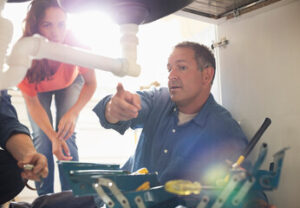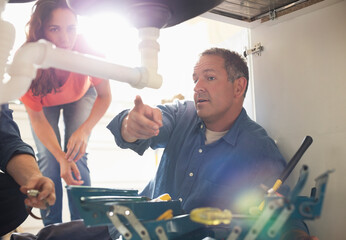Before you begin, shut off the water valve under your sink. Then use a screwdriver to loosen and remove the handle screws. Some faucets have decorative caps or hex-set screws; take these off and put them aside with the handle screws.
Next, loosen the large retaining nut with a wrench. Examine the old cartridge for damage and bring it with you to the hardware store if you need to find a replacement.
Cartridge faucets have a handle that controls water flow through a disc or ceramic-disk cylinder. They’re common in baths, kitchens, and laundry rooms and can be fairly easy to repair when the cartridge needs replaced. To start, shut off the water supply to the fixture and remove the handle. There are several ways to do this, but the most important thing is to make sure the handle is completely removed and the escutcheon (the flat plate that surrounds the handle) has been unscrewed or pulled off.
Depending on the model of the faucet, there is usually a retaining clip or nut that holds the cartridge in place. This may be exposed once the handle is removed, or it might be hidden by decorative collars and other parts. Once it’s loose, you can remove the cartridge and replace worn parts like the inlet seal or cam washer. You can also install new springs, valve seats, or neoprene seals in the base of the ceramic-disk cylinder.
When you’re replacing the cartridge, it is important to note its orientation so you can reinstall it in the same way. Most cartridges have one or two tabs that fit into notches on the faucet body. You can use a square-top plastic tool or adjustable wrench to loosen the cartridge and pliers to pull it straight up from the faucet body. Some water will likely come out with the cartridge, but that’s normal.
Once the old cartridge is removed, you can inspect it for damage or mineral deposits that might be causing it to leak. If the seat face is pitted or rough, sand it smooth with an emery cloth. This is a good time to clean the cartridge and the faucet body as well. A light coating of plumber’s grease on the O-rings will help prevent them from sticking when you reinstall the cartridge.
Install the new cartridge by lining up the tabs on it with the notches or slots in the retainer nut, clip, or screw. If necessary, you can twist the cartridge to get it into position. Screw the retaining nut or clip back into place. Reinstall the escutcheon and handle, and turn on the water to test the faucet for any leaks.
Ball
A ball is a round or nearly round body made of various materials and used in sports such as baseball, football, tennis, soccer, and golf. It can also refer to something spherical, like an armadillo or a person rolling up their fist into a ball. The word has also come to mean a person who is on the ball or someone who has a lot of intelligence and ability: “He was on the ball when it came to answering questions at the interview.”
If your soccer ball gets punctured, don’t throw it away; with some standard supplies, you can make a repair that will keep your ball playing like new. All the required supplies are readily available at any haberdashery or hardware store.
The first step is to locate the puncture hole. Fill the ball with water and rotate it, looking for bubbles to see where the air is coming from; this indicates where the leak is located. Once you have found the location, dry it completely before continuing with the repair process.
Once the ball is dry, take a screwdriver and cut the seam thread from the opposite side of the valve opening. This should be done carefully so as not to damage the interior of the ball.
Using a valve removal tool, force the hook end into the hole and pull to remove the old valve. If this is a difficult task, try lubricating the tool with some vaseline to make it easier to use. You will also need a new valve to replace the old one, which can be purchased at any sports goods store or from most online suppliers.
Once the new valve is in place, apply some sealant around the hole to prevent it from leaking. After applying a layer of sealant, wait for it to dry before putting the cover back on the ball. You may need to add more layers of glue if the hole continues to leak, but it is best to let each layer dry for at least 30 minutes before applying the next.
Ceramic Disc
As their name implies, disc faucets use a ceramic disk to control water flow. These cartridges are not as prone to leaks as the older washer-reliant ball or washerless cartridge types, but they can still suffer from cracked seals, damage to the disc, and the buildup of mineral deposits within the system. Fortunately, the same basic repair process that addresses these problems with other faucet types can be used to fix a ceramic disk faucet.
Begin the process by shutting off your home’s water supply, usually found at a valve underneath the sink. Once this is done, turn on the faucet and flush the system by running water through it for a few minutes. This removes any lingering debris in the pipes and prepares you to work on the cartridge and the assembly.
Many times, a leaking disk faucet is simply due to dirty seals or water ports. These can be cleaned using a nylon brush or an old toothbrush to clear away any built-up deposits. For a very stubborn deposit, an all-purpose cleaner such as acetone or lacquer thinner may be used to help dissolve it.
It’s also a good idea to clean the bottom of the cartridge, where the rubber seals can become damaged or layered with grit. A small screwdriver can be used to carefully remove these seals without damaging the ceramic disc. Once these are removed, the cartridge can be pulled straight up to expose a set screw that needs to be tightened.
Once the set screw has been tightened, replace the decorative cap and then screw the handle back onto the faucet body. Be careful not to overtighten this screw, as it could damage the delicate disc. It’s also a good idea to coat the new O-ring with a thin layer of plumber’s grease to ensure a snug fit.
When reassembling the faucet, be careful not to overtighten any of the screws, as this can break the ceramic disc. Be especially gentle when turning the water on, as the force of a full stream could cause it to crack. Once the system is reassembled, slowly test it by running water through it. If all is well, it’s time to enjoy your newly repaired ceramic disc faucet!
Valve Seat
A valve seat is the surface that seals and blocks a faucet’s opening for water flow. Over time, the seat can wear out and cause leaks. Replacing the valve seat can be a complicated repair job, and it’s not typically recommended for novice plumbers or homeowners who have never worked with plumbing before.
The valve seat can be worn out by several factors, including excessive water pressure or overuse. Wear can also occur due to a number of technical issues with the way the seat was originally inserted or machined. These include a lack of proper seating during the press-fitting process, distortion of the nominally circular valve seat surfaces, deviation of the machined seat surface from concentricity with the valve guide holes, and waviness or roughness of the valve seat material.
To determine if the valve seat is damaged, turn off the water supply and remove the handle. Look inside the body of the faucet for a place that looks like it would accept a screwdriver, and loosen the handle screw with a wrench or hex tool. Once the handle is removed, you can remove the valve by unscrewing the collar that holds it in place with adjustable pliers or a wrench. Next, remove the ball if you have a cartridge faucet or the disk if you have a disk cartridge faucet.
If the leak is located directly under the valve seat, you may have a broken seat. To replace a valve seat, remove the faucet stem and valve assembly from the body. With the adjusting ring still in place, unscrew the chrome cap with a wrench or by turning it counterclockwise. If the adjusting ring doesn’t turn, apply penetrating oil and try again.
Alternatively, you can reshape the old seat by placing it in a vise and using a long drift punch to tap the edge of the valve seat lip. This method can be used to reshape many different makes and models of head valve seats. However, it can be difficult to do without specialized tools that aren’t available at your local hardware store.

